
The May highflyer is a moth of the family Geometridae. It is found across the Palearctic region and the Near East although its range is largely determined by the presence of its larval food plant. The species was first described by Michael Denis and Ignaz Schiffermüller in 1775.
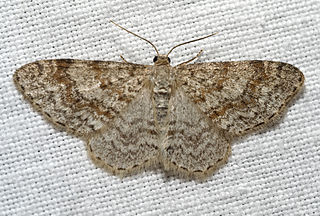
Larentiinae is a subfamily of moths containing roughly 5,800 species that occur mostly in the temperate regions of the world. They are generally considered a subfamily of the geometer moth family (Geometridae) and are divided into a few large or good-sized tribes, and numerous very small or even monotypic ones which might not always be valid. Well-known members are the "pug moths" of the Eupitheciini and the "carpets", mainly of the Cidariini and Xanthorhoini. The subfamily was described by Philogène Auguste Joseph Duponchel in 1845.
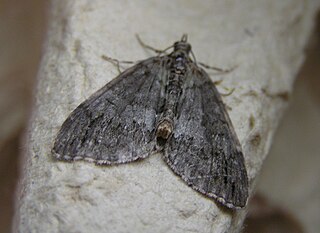
Hydriomena is a genus of moths in the family Geometridae described by Jacob Hübner in 1825.
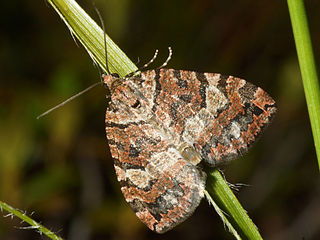
Hydriomena furcata, the July highflyer, is a moth of the family Geometridae. The species was first described by Carl Peter Thunberg in 1784. It is found in the Holarctic ecozone.

Scopula divisaria is a moth of the family Geometridae. It is found from the Indian subregion, Sri Lanka to Taiwan and Sulawesi.

Hydriomena ruberata, the ruddy highflyer, is a moth of the family Geometridae. The species was first described by Christian Friedrich Freyer in 1831. It is found from Ireland and Great Britain east to north-western Russia, and south up to the Alps. It is also present in North America.

Hydriomena? protrita is an extinct species of moth in the family Geometridae, and possibly in the modern genus Hydriomena. The species is known from late Eocene, Priabonian stage, lake deposits of the Florissant Formation in Teller County, Colorado, United States. It was first described by Theodore Dru Alison Cockerell in 1922.
Hydriomena catalinata is a moth in the family Geometridae. It is found in the southern United States, including Arizona and New Mexico.

Hydriomena transfigurata, the transfigured hydriomena moth, is a moth of the family Geometridae. It is found in North America, where it has been recorded from Alberta, Florida, Georgia, Indiana, Iowa, Kentucky, Maine, Manitoba, Maryland, Massachusetts, Minnesota, Missouri, New Brunswick, New Hampshire, New Jersey, New York, Newfoundland, North Carolina, Nova Scotia, Ohio, Oklahoma, Ontario, Quebec, South Carolina, Vermont, West Virginia and Wisconsin.
Hydriomena macdunnoughi is a species of moth in the family Geometridae. It was described by Louis W. Swett in 1918 and is found in North America, where it has been recorded from Yukon Territory to western Alberta and Colorado.
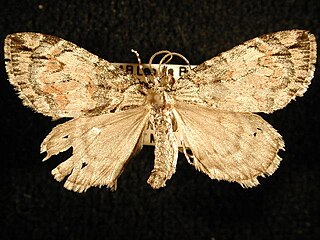
Hydriomena perfracta, the shattered hydriomena, is a species of geometrid moth in the family Geometridae. It is found in North America.
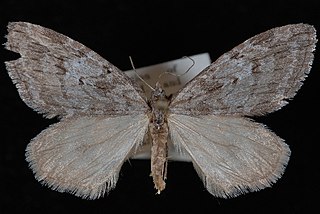
Hydriomena manzanita is a species of geometrid moth in the family Geometridae. It is found in North America.
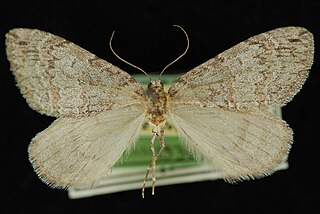
Hydriomena expurgata is a species of moth in the family Geometridae first described by William Barnes and James Halliday McDunnough in 1918. It is found in North America.

Hydriomena renunciata, the renounced hydriomena, is a species of geometrid moth in the family Geometridae. It is found in North America.
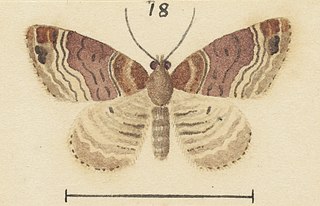
Hydriomena iolanthe is a species of moth in the family Geometridae. It is indigenous to New Zealand. This species is based on a single specimen that is now lost and has not been matched to any known species. As such it is classified as data deficient by the Department of Conservation.

Hydriomena canescens is a species of moth in the family Geometridae. It was first described by Alfred Philpott in 1918. This species is endemic to New Zealand. The classification of New Zealand endemic moths within the genus Hydriomena is regarded as unsatisfactory and in need of revision. As such this species is currently also known as Hydriomena (s.l.) canescens.
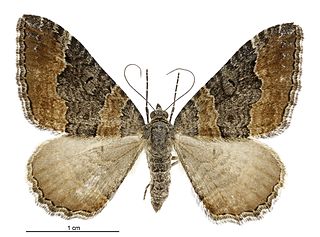
Hydriomena deltoidata is a species of moth in the family Geometridae. It was first described by Francis Walker in 1862. This species is endemic to New Zealand. The classification of New Zealand endemic moths within the genus Hydriomena is regarded as unsatisfactory and in need of revision. As such this species is currently also known as Hydriomena (s.l.) deltoidata. The adults of this moth are known to pollinate Dracophyllum acerosum and Leptospermum scoparium.
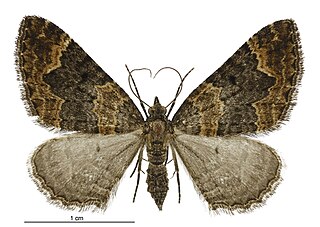
Hydriomena hemizona is a species of moth in the family Geometridae. It was first described by Edward Meyrick in 1897. This species is endemic to New Zealand. The classification of New Zealand endemic moths within the genus Hydriomena is regarded as unsatisfactory and in need of revision. As such this species is currently also known as Hydriomena (s.l.) hemizona.
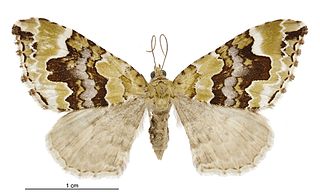
Hydriomena purpurifera is a species of moth in the family Geometridae. It was first described by Richard William Fereday in 1883. This species is endemic to New Zealand. The classification of New Zealand endemic moths within the genus Hydriomena is regarded as unsatisfactory and in need of revision. As such this species is currently also known as Hydriomena (s.l.) purpurifera.

















